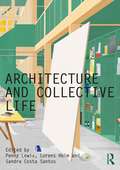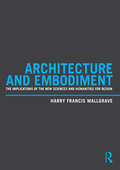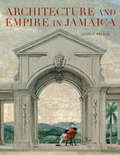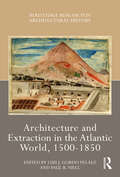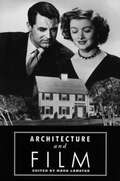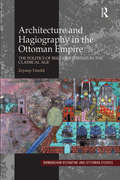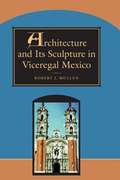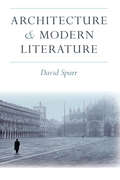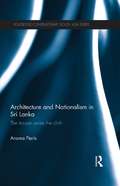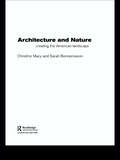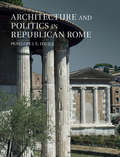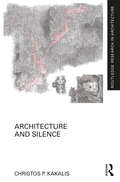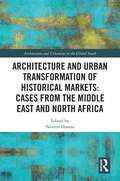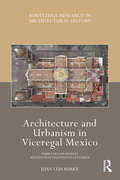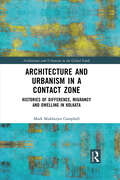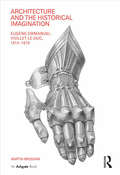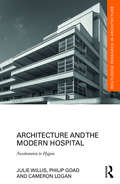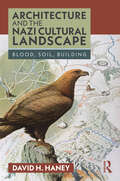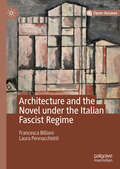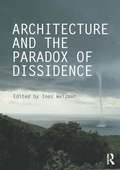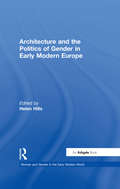- Table View
- List View
Architecture and Collective Life
by Penny LewisThis book addresses the complex relationship between architecture and public life. It’s a study of architecture and urbanism as cultural activity that both reflects and gives shape to our social relations, public institutions and political processes. Written by an international range of contributors, the chapters address the intersection of public life and the built environment around the themes of authority and planning, the welfare state, place and identity and autonomy. The book covers a diverse range of material from Foucault’s evolving thoughts on space to land-scraping leisure centres in inter-war Belgium. It unpacks concepts such as ‘community’ and ‘collectivity’ alongside themes of self-organisation and authorship. Architecture and Collective Life reflects on urban and architectural practice and historical, political and social change. As such this book will be of great interest to students and academics in architecture and urbanism as well as practicing architects.
Architecture and Embodiment: The Implications of the New Sciences and Humanities for Design
by Harry Francis MallgraveIn recent years we have seen a number of dramatic discoveries within the biological and related sciences. Traditional arguments such as "nature versus nurture" are rapidly disappearing because of the realization that just as we are affecting our environments, so too do these altered environments restructure our cognitive abilities and outlooks. If the biological and technological breakthroughs are promising benefits such as extended life expectancies, these same discoveries also have the potential to improve in significant ways the quality of our built environments. This poses a compelling challenge to conventional architectural theory... This is the first book to consider these new scientific and humanistic models in architectural terms. Constructed as a series of five essays around the themes of beauty, culture, emotion, the experience of architecture, and artistic play, this book draws upon a broad range of discussions taking place in philosophy, psychology, biology, neuroscience, and anthropology, and in doing so questions what implications these discussions hold for architectural design. Drawing upon a wealth of research, Mallgrave argues that we should turn our focus away from the objectification of architecture (treating design as the creation of objects) and redirect it back to those for whom we design: the people inhabiting our built environments.
Architecture and Empire in Jamaica
by Louis NelsonThrough Creole houses and merchant stores to sugar fields and boiling houses, Jamaica played a leading role in the formation of both the early modern Atlantic world and the British Empire. Architecture and Empire in Jamaica offers the first scholarly analysis of Jamaican architecture in the long 18th century, spanning roughly from the Port Royal earthquake of 1692 to Emancipation in 1838. In this richly illustrated study, which includes hundreds of the author's own photographs and drawings, Louis P. Nelson examines surviving buildings and archival records to write a social history of architecture.  Nelson begins with an overview of the architecture of the West African slave trade then moves to chapters framed around types of buildings and landscapes, including the Jamaican plantation landscape and fortified houses to the architecture of free blacks. He concludes with a consideration of Jamaican architecture in Britain. By connecting the architecture of the Caribbean first to West Africa and then to Britain, Nelson traces the flow of capital and makes explicit the material, economic, and political networks around the Atlantic. Â
Architecture and Extraction in the Atlantic World, 1500-1850 (Routledge Research in Architectural History)
by Luis Gordo Peláez Paul NiellThis edited collection examines the development of Atlantic World architecture after 1492. In particular, the chapters explore the landscapes of extraction as material networks that brought people, space, and labor together in harvesting raw materials, cultivating agriculture for export-level profits, and circulating raw materials and commodities in Europe, Africa, and the Americas from 1500 to 1850. This book argues that histories of extraction remain incomplete without careful attention to the social, physical, and mental nexus that is architecture, just as architecture’s development in the last 500 years cannot be adequately comprehended without attention to empire, extraction, colonialism, and the rise of what Immanuel Wallerstein has called the world system. This world system was possible because of built environments that enabled resource extraction, transport of raw materials, circulation of commodities, and enactment of power relations in the struggle between capital and labor. Separated into three sections: Harvesting the Environment, Cultivating Profit, and Circulating Commodities: Networks and Infrastructures, this volume covers a wide range of geographies, from England to South America, from Africa to South Carolina. The book aims to decenter Eurocentric approaches to architectural history to expose the global circulation of ideas, things, commodities, and people that constituted the architecture of extraction in the Atlantic World. In focusing on extraction, we aim to recover histories of labor exploitation and racialized oppression of interest to the global community. The book will be of interest to researchers and students of architectural history, geography, urban and labor history, literary studies, historic preservation, and colonial studies.
Architecture and Film
by Mark LamsterArchitecture and Film looks at the ways architecture and architects are treated on screen and, conversely, how these depictions filter and shape the ways we understand the built environment. It also examines the significant effect that the film industry has had on the American public's perception of urban, suburban, and rural spaces. Contributors to this collection of essays come from a wide range of disciplines. Nancy Levinson from Harvard Design Magazine writes on how films from The Fountainhead to Jungle Fever have depicted architects. Eric Rosenberg from Tufts University looks at how architecture and spatial relations shape the Beatles films A Hard Day's Night, Help!, and Let It Be. Joseph Rosa, curator at the National Building Museum, discusses why modern domestic architecture in recent Hollywood films such as The Ice Storm, L. A. Confidential, and The Big Lebowski has become synonymous with unstable inhabitants. I.D. Magazine writer Peter Hall discusses the history of film titling, focusing on the groundbreaking work of Saul Bass and Maurice Binder. Edited by Mark Lamster examines the anti-urbanism of the Star Wars trilogy. The collection also includes the voices of those from within the film industry, who are uniquely able to provide a "behind the scenes" perspective: film Edited by Bob Eisenhardt comments on the making of Concert of Wills, a documentary on the construction of the Getty Museum; and Robert Kraft focuses on his work as a location director for Diane Keaton's upcoming film about Los Angeles. Also included are interviews with David Rockwell, architect of numerous Planet Hollywood restaurants worldwide and designer of a new hall to host the Academy Awards ceremony; Kyle Kooper, who created title sequences for Seven and Mission Impossible; and motion picture art director Jan Roelfs, whose credits include Gattaca, Orlando, and Little Women.
Architecture and Hagiography in the Ottoman Empire: The Politics of Bektashi Shrines in the Classical Age
by Zeynep YürekliBased on a thorough examination of buildings, inscriptions, archival documents and hagiographies, this book uncovers the political significance of Bektashi shrines in the Ottoman imperial age. It thus provides a fresh and comprehensive account of the formative process of the Bektashi order, which started out as a network of social groups that took issue with Ottoman imperial policies in the late fifteenth century, was endorsed imperially as part of Bayezid II's (r. 1481-1512) soft power policy, and was kept in check by imperial authorities as the Ottoman approach to the Safavid conflict hardened during the rest of the sixteenth century. This book demonstrates that it was a combination of two collective activities that established the primary parameters of Bektashi culture from the late fifteenth century onwards. One was the writing of Bektashi hagiographies; they linked hitherto distinct social groups (such as wandering dervishes and warriors) with each other through the lives of historical figures who were their patron saints, idols and identity markers (such as the saint Hacı BektaÅŸ and the martyr Seyyid Gazi), while incorporating them into Ottoman history in creative ways. The other one was the architectural remodelling of the saints' shrines. In terms of style, imagery and content, this interrelated literary and architectural output reveals a complicated process of negotiation with the imperial order and its cultural paradigms. Examined in more detail in the book are the shrines of Seyyid Gazi and Hacı BektaÅŸ and associated legends and hagiographies. Though established as independent institutions in medieval Anatolia, they were joined in the emerging Bektashi network under the Ottomans, became its principal centres and underwent radical architectural transformation, mainly under the patronage of raider commanders based in the Balkans. In the process, they thus came to occupy an intermediary socio-political zone between the Ottoman empire and its contestants in the sixteenth century.
Architecture and Its Sculpture in Viceregal Mexico
by Robert J. MullenThis book grew out of the author's twenty-five-year exploration of Mexico's architectural and sculptural heritage. Combining an enthusiast's love for the subject with a scholar's care for accuracy, it is the perfect introduction to the full range of Mexico's colonial architecture.
Architecture and Mathematics in Ancient Egypt
by Corinna RossiIn this fascinating study, architect and Egyptologist Corinna Rossi analyses the relationship between mathematics and architecture in ancient Egypt by exploring the use of numbers and geometrical figures in ancient architectural projects and buildings. While previous architectural studies have searched for abstract â ~universal rules' to explain the history of Egyptian architecture, Rossi attempts to reconcile the different approaches of archaeologists, architects and historians of mathematics into a single coherent picture. Using a study of a specific group of monuments, the pyramids, and placing them in the context of their cultural and historical background, Rossi argues that theory and practice of construction must be considered as a continuum, not as two separated fields, in order to allow the original planning process of a building to re-emerge. Highly illustrated with plans, diagrams and figures, this book is essential reading for all scholars of Ancient Egypt and the architecture of ancient cultures.
Architecture and Modern Literature
by David SpurrArchitecture and Modern Literature explores the representation and interpretation of architectural space in modern literature from the early nineteenth century to the present, with the aim of showing how literary production and architectural construction are related as cultural forms in the historical context of modernity. In addressing this subject, it also examines the larger questions of the relation between literature and architecture and the extent to which these two arts define one another in the social and philosophical contexts of modernity. Architecture and Modern Literature will serve as a foundational introduction to the emerging interdisciplinary study of architecture and literature. David Spurr addresses a broad range of material, including literary, critical, and philosophical works in English, French, and German, and proposes a new historical and theoretical overview of this area, in which modern forms of "meaning" in architecture and literature are related to the discourses of being, dwelling, and homelessness.
Architecture and Nationalism in Sri Lanka: The Trouser Under the Cloth (Routledge Contemporary South Asia Series)
by Anoma PierisThe role of the home, the domestic sphere and the intimate, ethno-cultural identities that are cultivated within it, are critical to understanding the polemical constructions of country and city; tradition and modernity; and regionalism and cosmopolitanism. The home is fundamental to ideas of the homeland that give nationalism its imaginative form and its political trajectory. This book explores positions that are vital to ideas of national belonging through the history of colonial, bourgeois self-fashioning and post colonial identity construction in Sri Lanka. The country remains central to related architectural discourses due to its emergence as a critical site for regional architecture, post-independence. Suggesting patterns of indigenous accommodation and resistance that are expressed through built form, the book argues that the nation grows as an extension of an indigenous private sphere, ostensibly uncontaminated by colonial influences, domesticating institutions and appropriating rural geographies in the pursuit of its hegemonic ideals. This ambitious, comprehensive, wide-ranging book presents an abundance of new and original material and many imaginative insights into the history of architecture and nationalism from the mid nineteenth century to the present day.
Architecture and Nature: Creating the American Landscape
by Sarah Bonnemaison Christine MacyWinner of the 2006 Alice Davis Hitchcock Award! The word 'nature' comes from natura, Latin for birth - as do the words nation, native and innate. But nature and nation share more than a common root, they share a common history where one term has been used to define the other. In the United States, the relationship between nation and nature has been central to its colonial and post-colonial history, from the idea of the noble savage to the myth of the frontier. Narrated, painted and filmed, American landscapes have been central to the construction of a national identity. Architecture and Nature presents an in-depth study of how changing ideas of what nature is and what it means for the country have been represented in buildings and landscapes over the past century.
Architecture and Politics in Republican Rome
by Davies Penelope J. E.Architecture and Politics in Republican Rome is the first book to explore the intersection between Roman Republican building practices and politics (c. 509-44 BCE). At the start of the period, architectural commissions were carefully controlled by the political system; by the end, buildings were so widely exploited and so rhetorically powerful that Cassius Dio cited abuse of visual culture among the reasons that propelled Julius Caesar's colleagues to murder him in order to safeguard the Republic. In an engaging and wide-ranging text, Penelope J. E. Davies traces the journey between these two points, as politicians developed strategies to manoeuver within the system's constraints. She also explores the urban development and image of Rome, setting out formal aspects of different types of architecture and technological advances such as the mastery of concrete. Elucidating a rich corpus of buildings that have been poorly understand, Davies demonstrates that Republican architecture was much more than a formal precursor to that of imperial Rome.
Architecture and Ritual in the Churches of Constantinople
by Vasileios MarinisThis book examines the interchange of architecture and ritual in the Middle and Late Byzantine churches of Constantinople (ninth to fifteenth centuries). It employs archaeological and archival data, hagiographic and historical sources, liturgical texts and commentaries, and monastic typika and testaments to integrate the architecture of the medieval churches of Constantinople with liturgical and extra-liturgical practices and their continuously evolving social and cultural context. The book argues against the approach that has dominated Byzantine studies: that of functional determinism, the view that architectural form always follows liturgical function. Instead, proceeding chapter by chapter through the spaces of the Byzantine church, it investigates how architecture responded to the exigencies of the rituals, and how church spaces eventually acquired new uses. The church building is described in the context of the culture and people whose needs it was continually adapted to serve. Rather than viewing churches as frozen in time (usually the time when the last brick was laid), this study argues that they were social constructs and so were never finished, but continually evolving.
Architecture and Silence (Routledge Research in Architecture)
by Christos P. KakalisThis book explores the role of silence in how we design, present and experi-ence architecture. Grounded in phenomenological theory, the book builds on historical, theoretical and practical approaches to examine silence as a methodological tool of architectural research and unravel the experiential qualities of the design process. Distinct from an entirely soundless experience, silence is proposed as a material condition organically incorporated into the built and natural landscape. Kakalis argues that, either human or atmospheric, silence is a condition of waiting for a sound to be born or a new spatio-temporal event to emerge. In silence, therefore, we are attentive and attuned to the atmos-phere of a place. The book unpacks a series of stories of silence in religious topographies, urban landscapes, film and theatre productions and architec-tural education with contributed chapters and interviews with Jeff Malpas and Alberto Pérez-Gómez. Aimed at postgraduate students, scholars and researchers in architectural theory, it shows how performative and atmospheric qualities of silence can build a new understanding of architectural experience.
Architecture and Urban Transformation of Historical Markets: Cases from the Middle East and North Africa (Architecture and Urbanism in the Global South)
by Neveen HamzaThis book explores the complex relationship between societies, architecture, and urbanism of market halls, traditional souqs, bazaars, and speciality street markets in the Middle East and North Africa. It addresses how these trading environments influence perceptions of place and play an extended social, political, and religious role while adapting to their local climates. Through Archival research and social science methodologies, this book records and maps markets in urban fabrics, expanding on practices underlying the push towards historical listings and the development of markets as landmarks in the urban fabric. The role of markets in delivering sustainable place-making strategies and influencing the development of cities’ socio-economic and historical strength is addressed as key to their survival in the urban fabric and as place-making landmarks for preserving tangible and intangible heritage. Going beyond heritage and conservation studies, this book discusses how positioning and restoring markets challenges urban renewal policies, access to public space planning, environmental sustainability, security of food supply, cultural heritage, and tourism. This is an ideal read for those interested in the history of urban development, architecture and urban planning, and architectural heritage.
Architecture and Urbanism in Viceregal Mexico: Puebla de los Ángeles, Sixteenth to Eighteenth Centuries (Routledge Research in Architectural History)
by Juan Luis BurkeArchitecture and Urbanism in Viceregal Mexico presents a fascinating survey of urban history between the sixteenth and eighteenth centuries. It chronicles the creation and development of Puebla de los Ángeles, a city located in central-south Mexico, during its viceregal period. Founded in 1531, the city was established as a Spanish settlement surrounded by important Indigenous towns. This situation prompted a colonial city that developed along Spanish colonial guidelines but became influenced by the native communities that settled in it, creating one of the most architecturally rich cities in colonial Spanish America, from the Renaissance to the Baroque periods. This book covers the city's historical background, investigating its civic and religious institutions as represented in selected architectural landmarks. Throughout the narrative, Burke weaves together sociological, anthropological, and historical analysis to discuss the city’s architectural and urban development. Written for academics, students, and researchers interested in architectural history, Latin American studies, and the Spanish American viceregal period, it will make an important contribution to the field.
Architecture and Urbanism in a Contact Zone: Histories of Difference, Migrancy and Dwelling in Kolkata (Architecture and Urbanism in the Global South)
by Mark Mukherjee CampbellThis book explores how histories of migration, cultural encounter and transculturation have shaped formations of urban space, domestic architecture and cultural modernity in Kolkata from the early colonial period to the beginning of the era of India’s economic liberalization. It charts how these themes were manifest in what was an important ‘contact zone’ in the history of globalization and the modern city. Drawing on a wide range of resources and representations, from urban plans and architectural drawings to European travel journals and Bengali literature and cinema, the book investigates the history of Kolkata through an examination of key urban and architectural spaces across the colonial and postcolonial epochs. Through illustrated chapters, it sheds new light on questions of difference and segregation, cultural hybridity, migration, and entanglements of tradition and modernity in the city, analyzing spaces inhabited by a diverse range of cultures, including several neglected in previous studies. Architecture and Urbanism in a Contact Zone offers an instructive contribution to the fields of global architectural history and theory, urban studies and postcolonial cultural studies for scholars, researchers and students alike.
Architecture and the Historical Imagination: Eugène-Emmanuel Viollet-le-Duc, 1814–1879
by Martin BressaniHailed as one of the key theoreticians of modernism, Eugène-Emmanuel Viollet-le-Duc was also the most renowned restoration architect of his age, a celebrated medieval archaeologist and a fervent champion of Gothic revivalism. He published some of the most influential texts in the history of modern architecture such as the Dictionnaire raisonné de l’architecture française du XIe au XVIe siècle and Entretiens sur l’architecture, but also studies on warfare, geology and racial history. Martin Bressani expertly traces Viollet-le-Duc’s complex intellectual development, mapping the attitudes he adopted toward the past, showing how restoration, in all its layered meaning, shaped his outlook. Through his life journey, we follow the route by which the technological subject was born out of nineteenth-century historicism.
Architecture and the Modern Hospital: Nosokomeion to Hygeia (Routledge Research in Architecture)
by Cameron Logan Julie Willis Philip GoadMore than any other building type in the twentieth century, the hospital was connected to transformations in the health of populations and expectations of lifespan. From the scale of public health to the level of the individual, the architecture of the modern hospital has reshaped knowledge about health and disease and perceptions of bodily integrity and security. However, the rich and genuinely global architectural history of these hospitals is poorly understood and largely forgotten. This book explores the rapid evolution of hospital design in the twentieth century, analysing the ways in which architects and other specialists reimagined the modern hospital. It examines how the vast expansion of medical institutions over the course of the century was enabled by new approaches to architectural design and it highlights the emerging political conviction that physical health would become the cornerstone of human welfare.
Architecture and the Nazi Cultural Landscape: Blood, Soil, Building
by David H. HaneyThis book traces cultural landscape as the manifestation of the state and national community under the Nazi regime, and how the Nazi era produced what could be referred to as a totalitarian cultural landscape. For the Nazi regime, cultural landscape was indeed a heritage resource, but it was much more than that: cultural landscape was the nation. The project of Nazi racial purification and cultural renewal demanded the physical reshaping and reconceptualization of the existing environment to create the so-called "new Nazi cultural landscape." One of the most important components of this was a set of monumental sites thought to embody blood and soil beliefs through the harmonious synthesis of architecture and landscape. This special group of "landscape-bound" architectural complexes was interconnected by the new autobahn highway system, itself thought to be a monumental work embedded in nature. Behind this intentionally aestheticized view of the nation as cultural landscape lay the all-pervasive system of deception and violence that characterized the emerging totalitarian state. This is the first historical study to consider the importance of these monumental sites together with the autobahn as evidence of key Nazi cultural and geographic strategies during the pre-war years. This book concludes by examining racial and nationalistic themes underlying cultural landscape concepts today, against this historic background.
Architecture and the Nazi Cultural Landscape: Blood, Soil, Building
by David H. HaneyThis book traces cultural landscape as the manifestation of the state and national community under the Nazi regime, and how the Nazi era produced what could be referred to as a totalitarian cultural landscape.For the Nazi regime, cultural landscape was indeed a heritage resource, but it was much more than that: cultural landscape was the nation. The project of Nazi racial purification and cultural renewal demanded the physical reshaping and reconceptualization of the existing environment to create the so-called "new Nazi cultural landscape." One of the most important components of this was a set of monumental sites thought to embody blood and soil beliefs through the harmonious synthesis of architecture and landscape. This special group of "landscape-bound" architectural complexes was interconnected by the new autobahn highway system, itself thought to be a monumental work embedded in nature. Behind this intentionally aestheticized view of the nation as cultural landscape lay the all-pervasive system of deception and violence that characterized the emerging totalitarian state.This is the first historical study to consider the importance of these monumental sites together with the autobahn as evidence of key Nazi cultural and geographic strategies during the pre-war years. This book concludes by examining racial and nationalistic themes underlying cultural landscape concepts today, against this historic background.
Architecture and the Novel under the Italian Fascist Regime
by Francesca Billiani Laura PennacchiettiArchitecture and the Novel under the Italian Fascist Regime discusses the relationship between the novel and architecture during the Fascist period in Italy (1922-1943). By looking at two profoundly diverse aesthetic phenomena within the context of the creation of a Fascist State art, Billiani and Pennacchietti argue that an effort of construction, or reconstruction, was the main driving force behind both projects: the advocated “revolution” of the novel form (realism) and that of architecture (rationalism). The book is divided into seven chapters, which in turn analyze the interconnections between the novel and architecture in theory and in practice. The first six chapters cover debates on State art, on the novel and on architecture, as well as their historical development and their unfolding in key journals of the period. The last chapter offers a detailed analysis of some important novels and buildings, which have in practice realized some of the key principles articulated in the theoretical disputes.
Architecture and the Origins of Preclassic Maya Politics
by James DoyleArchitecture and the Origins of Preclassic Maya Politics highlights the dramatic changes in the relationship of ancient Maya peoples to the landscape and to each other in the Preclassical period (ca. 2000 BC-250 AD). Offering a comprehensive history of Preclassic Maya society, James Doyle focuses on recent discoveries of early writing, mural painting, stone monuments, and evidence of divine kingship that have reshaped our understanding of cultural developments in the first millennium BC. He also addresses one of the crucial concerns of contemporary archaeology: the emergence of political authorities and their subjects in early complex polities. Doyle shows how architectural trends in the Maya Lowlands in the Preclassic period exhibit the widespread cross-cultural link between monumental architecture of imposing intent, human collaboration, and urbanism.
Architecture and the Paradox of Dissidence
by Ines WeizmanArchitecture and the Paradox of Dissidence maps out and expands upon the methodologies of architectural action and reinvigorates the concept of dissent within the architectural field. It expands the notion of dissidence to other similar practices and strategies of resistance, in a variety of historical and geographical contexts.The book also discusses how the gestures and techniques of past struggles, as well as ‘dilemmas’ of working in politically suppressive regimes, can help to inform those of today. This collection of essays from expert scholars demonstrates the multiple responses to this subject, the potential and dangers of dissidence, and thus constructs a robust lexicon of concepts that will point to possible ways forward for politically and theoretically committed architects and practitioners.
Architecture and the Politics of Gender in Early Modern Europe (Women and Gender in the Early Modern World)
by Helen HillsWritten by leading scholars in the field, the essays in this book address the relationships between gender and the built environment, specifically architecture, in early modern Europe. In recent years scholars have begun to investigate the ways in which architecture plays a part in the construction of gendered identities. So far the debates have focused on the built environment of the nineteenth and twentieth centuries to the neglect of the early modern period. This book focuses on early modern Europe, a period decisive for our understanding of gender and sexuality. Much excellent scholarship has enhanced our understanding of gender division in early modern Europe, but often this scholarship considers gender in isolation from other vital factors, especially social class. Central to the concerns of this book, therefore, is a consideration of the intersections of gender with social rank. Architecture and the Politics of Gender in Early Modern Europe makes a major contribution to the developing analysis of how architecture contributes to the shaping of social relations, especially in relation to gender, in early modern Europe.
